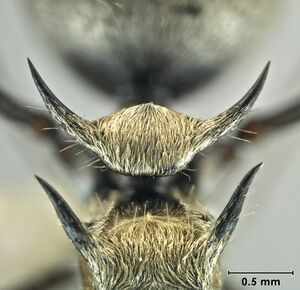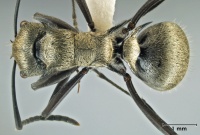Polyrhachis cupreata
| Polyrhachis cupreata | |
|---|---|

| |
| Scientific classification | |
| Kingdom: | Animalia |
| Phylum: | Arthropoda |
| Class: | Insecta |
| Order: | Hymenoptera |
| Family: | Formicidae |
| Subfamily: | Formicinae |
| Tribe: | Camponotini |
| Genus: | Polyrhachis |
| Subgenus: | Hedomyrma |
| Species: | P. cupreata |
| Binomial name | |
| Polyrhachis cupreata Emery, 1895 | |
| Synonyms | |
| |
I have seen only one nest of P. cupreata, situated at the base of clumped Pandanus leaves and constructed of vegetation debris bonded with brownish silk (Kohout 1988).
Identification
Kohout (1988) - In P. cupreata the whole dorsum of the body is covered with a pale golden pubescence. In contrast, the pubescence in Polyrhachis daemeli is always silvery and is virtually absent from its pronotal dorsum, while in Polyrhachis hermione it is of a rich golden hue and covers most of the body, except the gaster. The mesonotum of hermione is strongly transverse, while it is only slightly wider than long in the other two species.
Distribution
Confined to the coastal wetlands of North Queensland, with records from the Torres Strait islands south to Townsville, and the Northern Territory, where it has been taken on Cobourg Peninsula and near Darwin (Kohout 1988).
Latitudinal Distribution Pattern
Latitudinal Range: -10.76666641° to -19.25983°.
| North Temperate |
North Subtropical |
Tropical | South Subtropical |
South Temperate |
- Source: AntMaps
Distribution based on Regional Taxon Lists
Australasian Region: Australia (type locality).
Distribution based on AntMaps
Distribution based on AntWeb specimens
Check data from AntWeb
Countries Occupied
| Number of countries occupied by this species based on AntWiki Regional Taxon Lists. In general, fewer countries occupied indicates a narrower range, while more countries indicates a more widespread species. |

|
Estimated Abundance
| Relative abundance based on number of AntMaps records per species (this species within the purple bar). Fewer records (to the left) indicates a less abundant/encountered species while more records (to the right) indicates more abundant/encountered species. |

|
Biology
Castes

| |
| . | |
Nomenclature
The following information is derived from Barry Bolton's Online Catalogue of the Ants of the World.
- cupreata. Polyrhachis hermione var. cupreata Emery, 1895g: 357 (w.) AUSTRALIA. Combination in P. (Hedomyrma): Emery, 1925b: 190. Raised to species and senior synonym of exlex: Kohout, 1988c: 433.
- exlex. Polyrhachis (Hedomyrma) daemeli var. exlex Forel, 1915b: 110 (w.) AUSTRALIA. Junior synonym of cupreata: Kohout, 1988c: 433.
Type Material
- Polyrhachis (Hedomyrma) daemeli exlex Forel, 1915: Holotype, worker (uncertain), Yarrabah, Queensland, Australia, Naturhistoriska Riksmuseet.
- Polyrhachis hermione cupreata Emery, 1895: Holotype, worker, Cairns (as Cairus), Queensland, Australia, Museo Civico di Storia Naturale, Genoa.
Description
References
- Emery, C. 1895h. Descriptions de quelques fourmis nouvelles d'Australie. Ann. Soc. Entomol. Belg. 39: 345-358 (page 357, worker described)
- Emery, C. 1925d. Hymenoptera. Fam. Formicidae. Subfam. Formicinae. Genera Insectorum 183: 1-302 (page 190, Combination in P. (Hedomyrma))
- Kohout, R. J. 1988c. Nomenclatural changes and new Australian records in the ant genus Polyrhachis Fr. Smith (Hymenoptera: Formicidae: Formicinae). Mem. Qld. Mus. 25: 429-438 (page 433, Raised to species, and senior synonym of exlex)
- Robson, S. 2020. Spiny Ants (Polyrhachis). Encyclopedia of Social Insects, pp. 1–6. (doi:10.1007@978-3-319-90306-4_115-1).
References based on Global Ant Biodiversity Informatics
- Kohout R. J. 2000. A review of the distribution of the Polyrhachis and Echinopla ants of the Queensland wet tropics (Hymenoptera: Formicidae: Formicinae). Memoirs of the Queensland Museum 46: 183-209



